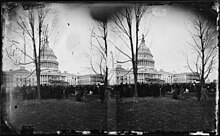39th United States Congress
| 39th United States Congress | |
|---|---|
|
38th ←
→ 40th
|
|

United States Capitol (1877)
|
|
| March 4, 1865 – March 4, 1867 | |
| Senate President |
Andrew Johnson (D) until April 15, 1865 Vacant from April 15, 1865 |
| Senate Pres. pro tem |
Lafayette S. Foster (R) Benjamin Wade (R) |
| House Speaker | Schuyler Colfax (R) |
| Members | 54 Senators 193 Representatives 9 Non-voting members |
| Senate Majority | Republican |
| House Majority | Republican |
| Sessions | |
|
Special: March 4, 1865 – March 11, 1865 1st: December 4, 1865 – July 28, 1866 2nd: December 3, 1866 – March 4, 1867 |
|
The Thirty-ninth United States Congress was a meeting of the legislative branch of the United States federal government, consisting of the United States Senate and the United States House of Representatives. It met in Washington, D.C. from March 4, 1865 to March 4, 1867, during the first month of Abraham Lincoln's fifth year as president, and the first two years of his successor, U.S. President Andrew Johnson.
The apportionment of seats in this House of Representatives was based on the Eighth Census of the United States in 1860. Both chambers had a Republican majority.
The count below identifies party affiliations at the beginning of the first session of this Congress, and includes members from vacancies and newly admitted states, when they were first seated. Changes resulting from subsequent replacements are shown below in the "Changes in membership" section.
During this Congress, two seats were added for the new state of Nebraska.
During this Congress, one seat was added for the new state of Nebraska.
This list is arranged by chamber, then by state. Senators are listed in order of seniority, and Representatives are listed by district.
Senators were elected by the state legislatures every two years, with one-third beginning new six-year terms with each Congress. Preceding the names in the list below are Senate class numbers, which indicate the cycle of their election. In this Congress, Class 1 meant their term began in the last Congress, requiring reelection in 1868; Class 2 meant their term began in this Congress, requiring reelection in 1870; and Class 3 meant their term ended in this Congress, requiring reelection in 1866.
The names of members of the House of Representatives are preceded by their district numbers.
(3 Republicans)
(4 Republicans)
(1 Democrat)
...
Wikipedia
